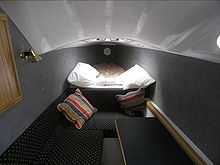Berth (sleeping)
The word berth was originally used to describe beds and sleeping accommodation on boats and ships and has now been extended to refer to similar facilities on trains, aircraft, buses and trucks.
Beds in boats or ships

While beds on large ships are little different from those on shore, the lack of space on smaller yachts means that bunks must be fit in wherever possible. Some of these berths have specific names:
- Quarter berth
- A single bunk tucked under the cockpit. Usually found in smaller boats where there is not room for a cabin in this location. Typically, the head and chest will be in the main saloon, with the remainder of the body extending into a "pipe" leading aft. Preferred by some skippers as they can be close to the cockpit while off-watch; there's also no possibility of falling out of bed.
- Settee berth
- The archetypal layout for a small yacht has seats running down both sides of the cabin, with a table in the middle. At night, these seats can usually be used as beds. Because the ideal ergonomic distance between a seat-back and its front edge (back of the knee) makes for a rather narrow bed, good settee berths will have a system for moving the back of the settee out of the way; this can reveal a surprisingly wide bunk, often running right out to the hull side underneath the lockers. If they are to be used at sea, settee berths must have lee-cloths to prevent the user falling out of bed. Sometimes the settee forms part of a double bed for use in harbour, often using detachable pieces of the table and extra cushions. Such beds are not usually referred to as settee berths.
_bunks.jpg) Sailors in their bunks aboard USS John C. Stennis (CVN-74).
Sailors in their bunks aboard USS John C. Stennis (CVN-74).
- Pilot berth
- A narrow berth high up in the side of the cabin, usually above and behind the back of the settee and right up under the deck. Sometimes the side of this bunk is "walled in" up to the sleeper's chest; there may even be small shelves or lockers on the partition so that the bed is "behind the furniture". The pilot berth is so called because originally they were so small and uncomfortable that nobody slept in them most of the time; only the pilot, if he had to spend a night on board, would be offered it.
- V-berth
- Almost all yachts have a bed in the extreme forward end of the hull (usually in a separate cabin called the forepeak). Because of the shape of the hull this bed is basically triangular, though most also have a triangular notch cut out of the middle of the aft end, splitting it partially into two separate beds and making it more of a V shape, hence the name. This notch can usually be filled in with a detachable board and cushion, creating something more like a double bed (though with drastically reduced space for the feet; 12" wide is typical). The term "V-berth" is not widely used in the UK, instead the cabin as a whole (the forepeak) is usually referred to.
Lee-Cloths
Unless the structure of the boat renders them unnecessary (quarter berths, pilot berths with partitions), bunks on a yacht must have lee-cloths to prevent the sleeper falling out due to the motion of the vessel. These are sheets of canvas attached to the open side of the bunk (very few are open all round) and usually tucked under the mattress during the day or when sleeping in harbour. Lengths of rope are attached to the upper corners of the lee-cloth, and fittings are provided above the bunk to which these lines can be tied, holding the cloth in place as a kind of wall across the open side of the bunk.
Lee cloths have some secondary uses:
- If the cloth is fairly tall, it can serve as a kind of curtain to the berth, in an attempt either to provide privacy (something of a lost cause on board a small boat) or to avoid being awakened by the activities of those on watch.
- Instead of tucking them under the mattress, some owners pull the lee-cloths across the top of the settee berths during rough weather, providing a protective cover for the fabric below and allowing the crew to sit down in wet oilskins without damaging it.
- Pilot berths are sometimes used as storage on short trips with large crews. Each person's kit is kept in a large bag or holdall, and during the day all bags are placed in the pilot berths and tied down under the leecloths.
Beds in trains
Long-distance trains running at night sometimes have beds in them, often in sleeping compartments, and the beds are known as sleeping berths, or just berths. In the case of compartments with two berths, one is on top of the other in a double-bunk arrangement. These beds (the lower bed in a double-bunk arrangement) are usually designed in conjunction with seats which occupy the same space, and each can be folded away when the other is in use.
Berths of long-distance trucks
Long-haul truckers sleep in berths when required by regulations to rest. The sleeper-berth must meet size and location requirements specified on the truck regulations.
See also
- Couchette car
- Pullman car